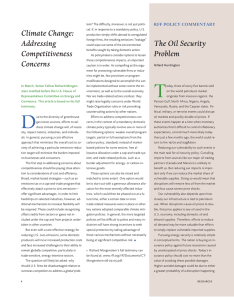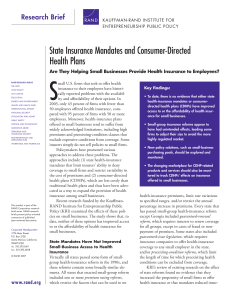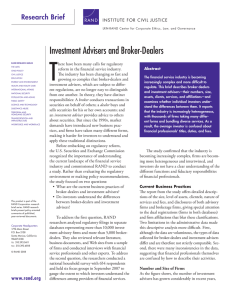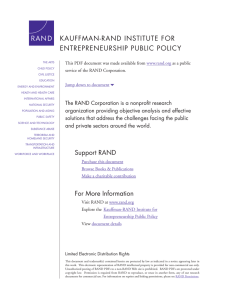M Is the Economic Burden of Providing Health Insurance Research Brief
advertisement
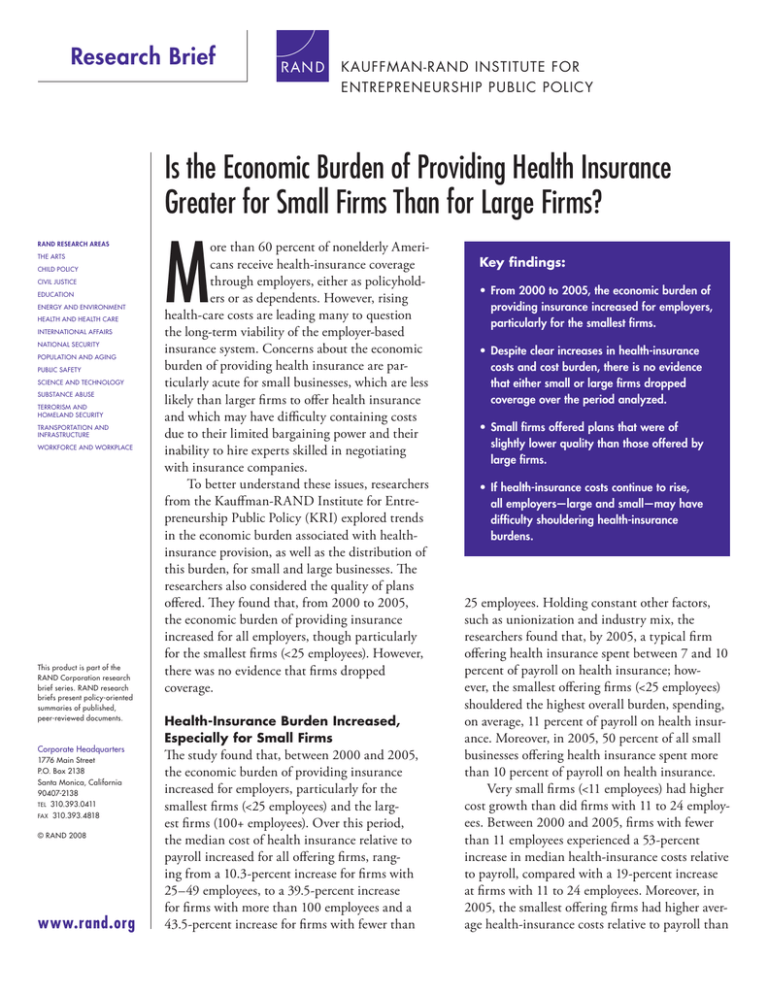
Research Brief KAUFFMAN-RAND INSTITUTE FOR ENTREPRENEURSHIP PUBLIC POLICY Is the Economic Burden of Providing Health Insurance Greater for Small Firms Than for Large Firms? RAND RESEARCH AREAS THE ARTS CHILD POLICY CIVIL JUSTICE EDUCATION ENERGY AND ENVIRONMENT HEALTH AND HEALTH CARE INTERNATIONAL AFFAIRS NATIONAL SECURITY POPULATION AND AGING PUBLIC SAFETY SCIENCE AND TECHNOLOGY SUBSTANCE ABUSE TERRORISM AND HOMELAND SECURITY TRANSPORTATION AND INFRASTRUCTURE WORKFORCE AND WORKPLACE This product is part of the RAND Corporation research brief series. RAND research briefs present policy-oriented summaries of published, peer-reviewed documents. Corporate Headquarters 1776 Main Street P.O. Box 2138 Santa Monica, California 90407-2138 TEL 310.393.0411 FAX 310.393.4818 © RAND 2008 www.rand.org M ore than 60 percent of nonelderly Americans receive health-insurance coverage through employers, either as policyholders or as dependents. However, rising health-care costs are leading many to question the long-term viability of the employer-based insurance system. Concerns about the economic burden of providing health insurance are particularly acute for small businesses, which are less likely than larger firms to offer health insurance and which may have difficulty containing costs due to their limited bargaining power and their inability to hire experts skilled in negotiating with insurance companies. To better understand these issues, researchers from the Kauffman-RAND Institute for Entrepreneurship Public Policy (KRI) explored trends in the economic burden associated with healthinsurance provision, as well as the distribution of this burden, for small and large businesses. The researchers also considered the quality of plans offered. They found that, from 2000 to 2005, the economic burden of providing insurance increased for all employers, though particularly for the smallest firms (<25 employees). However, there was no evidence that firms dropped coverage. Health-Insurance Burden Increased, Especially for Small Firms The study found that, between 2000 and 2005, the economic burden of providing insurance increased for employers, particularly for the smallest firms (<25 employees) and the largest firms (100+ employees). Over this period, the median cost of health insurance relative to payroll increased for all offering firms, ranging from a 10.3-percent increase for firms with 25–49 employees, to a 39.5-percent increase for firms with more than 100 employees and a 43.5-percent increase for firms with fewer than Key findings: • From 2000 to 2005, the economic burden of providing insurance increased for employers, particularly for the smallest firms. • Despite clear increases in health-insurance costs and cost burden, there is no evidence that either small or large firms dropped coverage over the period analyzed. • Small firms offered plans that were of slightly lower quality than those offered by large firms. • If health-insurance costs continue to rise, all employers—large and small—may have difficulty shouldering health-insurance burdens. 25 employees. Holding constant other factors, such as unionization and industry mix, the researchers found that, by 2005, a typical firm offering health insurance spent between 7 and 10 percent of payroll on health insurance; however, the smallest offering firms (<25 employees) shouldered the highest overall burden, spending, on average, 11 percent of payroll on health insurance. Moreover, in 2005, 50 percent of all small businesses offering health insurance spent more than 10 percent of payroll on health insurance. Very small firms (<11 employees) had higher cost growth than did firms with 11 to 24 employees. Between 2000 and 2005, firms with fewer than 11 employees experienced a 53-percent increase in median health-insurance costs relative to payroll, compared with a 19-percent increase at firms with 11 to 24 employees. Moreover, in 2005, the smallest offering firms had higher average health-insurance costs relative to payroll than Smaller Firms Offered Plans of Slightly Lower Quality did larger firms: Firms with fewer than 25 employees spent 11 percent of payroll on health insurance, compared with 7 percent at firms with 25–49 employees, 9 percent at firms with 50–99 employees, and 10 percent at firms with 100 or more employees. There was considerable variation in the level of healthinsurance burden among small firms. While, in 2005, 25 percent of small firms that offered insurance spent less than 6 percent of payroll on health care, another 25 percent spent in excess of 15 percent of payroll on health-insurance costs. The variation suggests that a “one-size-fits-all” policy to facilitate health-insurance provision at small businesses may be poorly targeted. An unexpected finding in this analysis was that both very small firms (<25 employees) and very large firms (>100 employees) have higher health-insurance burdens than do medium-sized firms (25–99 employees). A potential explanation for this is that take-up of health insurance at very small and very large firms is higher than that at medium-sized firms. Take-up at small firms may be high either because small employers that offer health insurance require all their employees to purchase coverage or because small employers that offer insurance have employees with unusually high demand for coverage. Overall, the study found that small firms offered plans that were of slightly lower quality than those offered by large firms. The research found that plans offered by small firms (<25 employees) had slightly lower actuarial values than those offered by large firms, especially for non-HMO plans (e.g., preferred-provider organizations [PPOs] and traditional fee-for-service plans) and for enrollees in the top 50 percent of expenditures. The study found that an average employee at a small firm would expect to spend 1.9 percent of annual earnings on outof-pocket health expenditures, while an average employee at a firm with more than 100 employees would expect to spend 1.3 percent of annual earnings on such expenses. Employees at small firms who have higher expenditures, such as older and sicker employees, may be particularly disadvantaged when they receive insurance through their employer. Overall, the results paint a mixed picture of the relative generosity of plans offered by small and large firms. Although health plans at large firms (100+ employees) are more likely to include prescription and dental coverage, and non-HMO plans offered by large firms have lower deductibles and coinsurance rates, HMO plans offered at large firms require higher copayments, and non-HMO plans offered at large firms are less likely to have an out-of-pocket maximum. Despite Higher Cost Burden, Firms Did Not Drop Insurance Coverage Employer-Based Health Insurance May Become Unaffordable If Costs Continue to Grow Despite clear increases in health-insurance costs and cost burden, there is no evidence that firms dropped coverage over the period analyzed. Health-insurance–offer rates remained relatively stable from 2000 to 2005, even for the smallest firms (<25 employees and <11 employees). These findings suggest that firms, and ultimately their employees, were willing to shoulder the burden of rising health-insurance costs even if it meant giving up increases in wages. However, it is unclear whether employers and their employees will be able to afford this burden in the future if health-insurance costs continue to outpace growth in payroll. The results of the study suggest that, if health-insurance costs continue to rise, all employers—large and small alike— may have difficulty shouldering health-insurance burdens. Although firms may pass insurance costs back to employees in the form of lower salaries, employees may be unwilling or unable to afford these cost increases in the future. This may be particularly true at very small firms, among which employees appear to be sacrificing a larger share of their salaries for a lower-quality benefit. ■ This research brief describes work done for the Kauffman-RAND Institute for Entrepreneurship Public Policy within the RAND Institute for Civil Justice documented in The Economic Burden of Providing Health Insurance: How Much Worse Off Are Small Firms?, by Christine Eibner, TR-559-EMKF (available at http://www.rand.org/pubs/technical_reports/TR559/), 2008, 80 pp., $23.00, ISBN: 978-0-8330-4411-2. The RAND Corporation is a nonprofit research organization providing objective analysis and effective solutions that address the challenges facing the public and private sectors around the world. RAND’s publications do not necessarily reflect the opinions of its research clients and sponsors. R® is a registered trademark. RAND Offices Santa Monica, CA • Washington, DC • Pittsburgh, PA • Jackson, MS / New Orleans, LA • Cambridge, UK • Doha, QA RB-9340-EMKF (2008) KAUFFMAN-RAND INSTITUTE FOR ENTREPRENEURSHIP PUBLIC POLICY THE ARTS CHILD POLICY This PDF document was made available from www.rand.org as a public service of the RAND Corporation. CIVIL JUSTICE EDUCATION ENERGY AND ENVIRONMENT HEALTH AND HEALTH CARE INTERNATIONAL AFFAIRS NATIONAL SECURITY This product is part of the RAND Corporation research brief series. RAND research briefs present policy-oriented summaries of individual published, peerreviewed documents or of a body of published work. POPULATION AND AGING PUBLIC SAFETY SCIENCE AND TECHNOLOGY SUBSTANCE ABUSE TERRORISM AND HOMELAND SECURITY TRANSPORTATION AND INFRASTRUCTURE The RAND Corporation is a nonprofit research organization providing objective analysis and effective solutions that address the challenges facing the public and private sectors around the world. WORKFORCE AND WORKPLACE Support RAND Browse Books & Publications Make a charitable contribution For More Information Visit RAND at www.rand.org Explore theKauffman-RAND Institute for Entrepreneurship Public Policy View document details Limited Electronic Distribution Rights This document and trademark(s) contained herein are protected by law as indicated in a notice appearing later in this work. This electronic representation of RAND intellectual property is provided for non-commercial use only. Unauthorized posting of RAND PDFs to a non-RAND Web site is prohibited. RAND PDFs are protected under copyright law. Permission is required from RAND to reproduce, or reuse in another form, any of our research documents for commercial use. For information on reprint and linking permissions, please see RAND Permissions.
